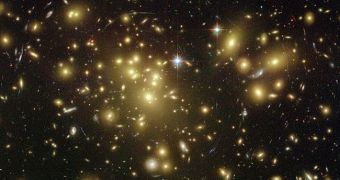A group of investigators has recently discovered the galaxies containing the largest concentrations of dark matter in the known Universe. The cosmic structures reside very close to the Milky Way, and are practically located in our back yard, experts at the Carnegie Observatories in Pasadena, California say. The report their findings in the July 28 issue of the online journal arXiv. The research group was led by Carnegie expert Joshua Simon, Science News reports.
Dark matter is a form of matter that astrophysicists believe makes up about 83 percent of the mass of the entire Universe. It is not visible through direct observations, but experts can infer its existence from the gravitational effects it has on normal surrounding matter. “Highways” made of the stuff are known to exist, which capture galaxies, forcing them to “flow” in established directions, and generate galaxy superclusters. But the stuff is not evenly distributed throughout the Universe, which means that larger concentrations can be found in some places.
Such is the case with the galaxy Segue 1, which was discovered in 2007 some 80,000 light-years away from our planet. The Carnegie crew, working together with colleagues from the Yale University led by expert Marla Geha, analyzed the cosmic structure in more detail, and learned that vast amounts of dark matter exist around it. Due to the fact that the galaxy is very close to the Milky Way, studying the halo will be an easy task. The joint group hopes to use this newly-found research opportunity to advance our knowledge of dark matter, and even to try and find it.
One of the things that attracted the team's attention to Segue 1 was the fact that the galaxy's stars had a combined mass of about 1,000 suns. While that in itself is not something to fret over, the mass of the entire galaxy was about 500 times larger. “That tells us that Segue 1 is made almost entirely of dark matter,” Simon believes. “It’s extremely important to figure out the dark matter properties of galaxies,” Wyse explains. “A detection of dark matter annihilation would be a breakthrough for both astronomy and particle physics, and the first step is figuring out where to look for it,” Simon concludes.

 14 DAY TRIAL //
14 DAY TRIAL //